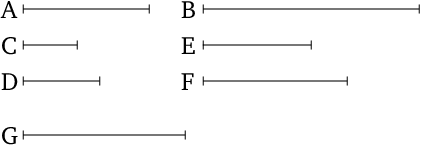Proof: By Euclid
(related to Proposition: Prop. 8.18: Between two Similar Plane Numbers exists one Mean Proportional)
- Let $A$ and $B$ be two similar plane numbers.
- And let the numbers $C$, $D$ be the sides of $A$, and $E$, $F$ (the sides) of $B$.
- And since similar numbers are those having proportional sides [Def. 7.21] , thus as $C$ is to $D$, so $E$ (is) to $F$.
- Therefore, I say that there exists one number in mean proportion to $A$ and $B$, and that $A$ has to $B$ a squared ratio with respect to that $C$ (has) to $E$, or $D$ to $F$ - that is to say, with respect to (that) a corresponding side (has) to a corresponding [side].

- For since as $C$ is to $D$, so $E$ (is) to $F$, thus, alternately, as $C$ is to $E$, so $D$ (is) to $F$ [Prop. 7.13].
- And since $A$ is plane, and $C$, $D$ its sides, $D$ has thus made $A$ (by) multiplying $C$.
- And so, for the same (reasons), $E$ has made $B$ (by) multiplying $F$.
- So let $D$ make $G$ (by) multiplying $E$.
- And since $D$ has made $A$ (by) multiplying $C$, and has made $G$ (by) multiplying $E$, thus as $C$ is to $E$, so $A$ (is) to $G$ [Prop. 7.17].
- But as $C$ (is) to $E$, [so] $D$ (is) to $F$.
- And thus as $D$ (is) to $F$, so $A$ (is) to $G$.
- Again, since $E$ has made $G$ (by) multiplying $D$, and has made $B$ (by) multiplying $F$, thus as $D$ is to $F$, so $G$ (is) to $B$ [Prop. 7.17].
- And it was also shown that as $D$ (is) to $F$, so $A$ (is) to $G$.
- And thus as $A$ (is) to $G$, so $G$ (is) to $B$.
- Thus, $A$, $G$, $B$ are continously proportional.
- Thus, there exists one number (namely, $G$) in mean proportion to $A$ and $B$.
- So I say that $A$ also has to $B$ a squared ratio with respect to (that) a corresponding side (has) to a corresponding side - that is to say, with respect to (that) $C$ (has) to $E$, or $D$ to $F$.
- For since $A$, $G$, $B$ are in continued proportion, $A$ has to $B$ a squared ratio with respect to (that $A$ has) to $G$ [Prop. 5.9].
- And as $A$ is to $G$, so $C$ (is) to $E$, and $D$ to $F$.
- And thus $A$ has to $B$ a squared ratio with respect to (that) $C$ (has) to $E$, or $D$ to $F$.
- (Which is) the very thing it was required to show.
∎
Thank you to the contributors under CC BY-SA 4.0! 

- Github:
-

- non-Github:
- @Fitzpatrick
References
Adapted from (subject to copyright, with kind permission)
- Fitzpatrick, Richard: Euclid's "Elements of Geometry"
